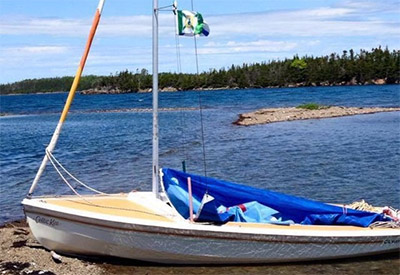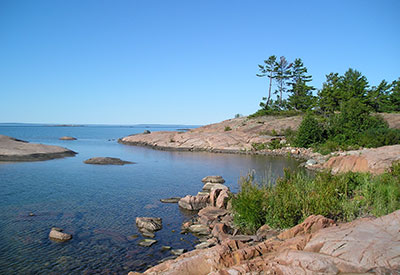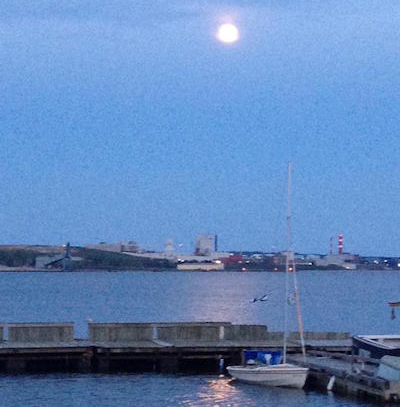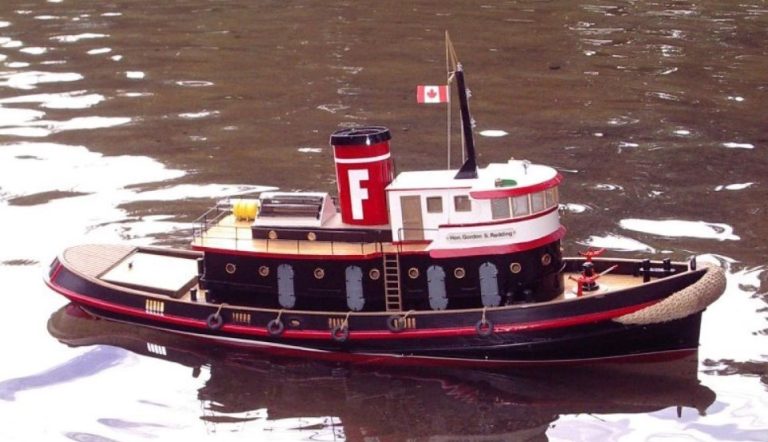RE-VISITING A FAMILY CAMPGROUND

Story and Photo by Rob Dunbar
Nova Scotia’s majestic coastline is often popularized by such great harbours, cove and bays that go by the name of Halifax, Peggy’s and Mahone Historic place names such as Lunenburg Louisbourg, Bridgewater and of course Oak Island; home to the worlds longest running treasure hunt also dot the map.
Our ocean playground is also home to the rugged and beautiful Eastern shore, record breaking high tides of the Bay of Fundy and the warm waters of the Northumberland Strait that is shared with New Brunswick and Prince Edward Island.
Photo Caption: Celtic Kiss at rest on Rabbit Island
Nova Scotia’s jewel is none other than Cape Breton Island and its famous Bras d’or Lakes is not only a beauty to behold but is also the resting place of Alexander Graham Bell.
However, there is one body of water that is often ignored even though it is a pivotal shipping lane connecting the Atlantic Ocean to ports in Montreal and others of the Great Lakes via the St Lawrence Seaway. That being the Strait of Canso which separates mainland Nova Scotia from Cape Breton Island and is also home to the gateway of the Bras d’or Lakes. In order to transit from the Atlantic Ocean to the Bras d’or Lakes from the south one must go through Lennnox passage in Inhabitants Bay.
Lennox passage is a beautiful corridor into the lakes and is also gated by a beautiful archipelago in Inhabitants Bay if lucky enough one may also see a supertanker anchored in the bay waiting to enter oil terminal in Strait of Canso or a pod of whales searching for food.
The archipelago is bordered by the Acadian founded island of Janvrin and is dotted by; Rabbit, Evans, Freeman and Round islands that are well protected from the harshest winds the Atlantic ocean can offer.
A family favourite in this archipelago is Rabbit Island first visited by my grandfather who I credit as the original dinghy sailor in the family in the 1920s and 30s. He used to go there with family for camping trips so for me to visit this island is like reconnecting with my past.
On this particular morning Celtic Kiss surfed on a fast broad reach down the Strait of Canso and rounded Bear Head towards Cape Breton. A shift in wind quickly changed my port tack beam reach into an adrenaline rushing broad reach to Rabbit Island. On approaching the island, the wind began to build prompting the need to reef the mainsail but opted not to furl the jib to further slow down my progress as I knew Would be needed in a matter of minutes to head up to a particular sandbar to land on.
With a building aft wind on my approach to the safe haven of the island my speed was increasing in an area I knew had hidden Shoals waiting to feast Kiss’ fibreglass.
An Hour and a half after leaving Venus Cove, Celtic Kiss was on final approach to Rabbit Island. Going much faster than I had wanted I swiftly pulled onto the sandbar that I had landed on 30 years’ prior with my parents and late Uncle Charlie Dunbar who introduced me to sailing I immediately noticed that over time the sandbar had eroded and is not as big or as solid as I had remembered. On setting foot on the island for the first time in 30 years I shouted in jubilation!!
After having spent many hours walking The same paths that my grandparents once trod I returned to Celtic Kiss. With a diminishing northerly wind Celtic Kiss was prepared for the 8 mile beat back home to Venus Cove.
Contrary to my calculations I had originally anticipated on a 3 mile beam reach from Rabbit Island to Bear Head before turning north word into the strait however soon after departing Rabbit Island The wind shifted 90° forcing me to deal with a headwind rather than a beam reach. On reaching Bear Head the wind velocity increased and shifted back 90° to the original north wind funnelling down the strait.
Once again the increase in velocity dictated a reef in the main however I knew this would be short-lived as the land breeze would eventually die down to something more manageable. To further complicate matters June is lobster season in this area thus my navigation not only had to deal with a 5-mile upwind leg to Venus Cove I also had to dodge lobster traps on either side of the strait which was an added headache to take full advantage of tacking upwind.
It was during this portion of my trip I remembered stories of my grandfather talking about my great uncle John. My grandfather would be in the backyard watching my great uncle John Maguire sailing his schooner Gertrude L Maguire formally known as The famous Rumrunner, Nellie J Banks, sailing up the strait. And here I am now almost 80 years later following my great Uncle John Maguire’s footsteps.
With about 2 miles to go to Venus Cove the wind had subsided. My grandfather always said ” when the sun goes down the wind goes down in the strait”. Once again he was right!
Switching heavy air tactics to light air tactics and 4 1/2 hours after departing Rabbit Island Celtic kiss was safely secured at the Mulgrave Marine Park at Venus Cove.





























